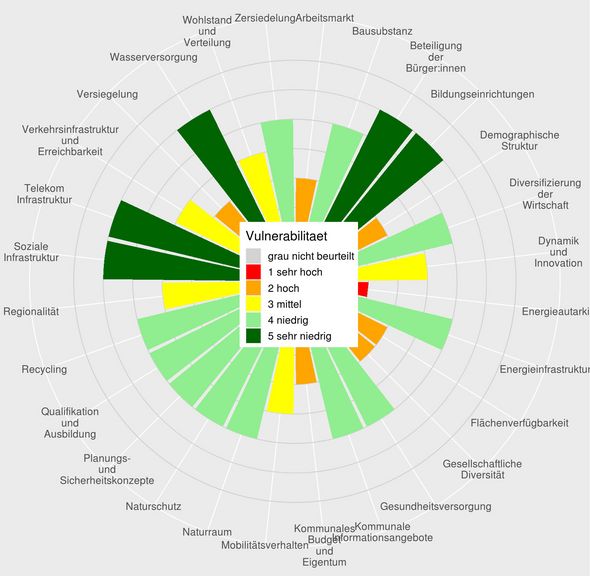Austria's cities are increasingly confronted with the impacts of climate change, which threaten their built, blue, and green infrastructure systems as well as the quality of life of their populations. The VESPA project (rapid vulnerability analysis for practical application in cities) has developed a prototype for a rapid vulnerability assessment, providing cities with an evidence-based foundation to evaluate risks and challenges. Using a web-based tool, Austrian cities can create and analyze individual vulnerability profiles. The project’s key objectives included:
- Addressing open questions regarding urban vulnerability,
- Developing appropriate indicators for data-based analysis, and
- Creating specific vulnerability profiles.
Indicator-Based Analysis and Data Integration
The project methodology relies on 32 core indicators some of which can be collected quickly and easily from Austria-wide data sources, as well as 36 supplementary indicators that are locally determined. These indicators encompass economic, social, and infrastructural conditions that define a city’s individual susceptibility to crises. This data-based analysis is complemented by qualitative assessments from local stakeholders to provide a comprehensive picture of urban challenges.
Example Application: City of Lienz
The example of Lienz demonstrated which data can be used in the action areas of “mobility transition” (e.g., commuter data, modal split), “energy transition” (e.g., energy consumption across sectors, waste heat potential, share of renewable energy), and “local circular economy” (e.g., land consumption, building land reserves, waste/wastewater volumes, per capita material consumption) and how available and reliable the data is.
Practical Application: Prototype of a Web-Based Tool
To ensure the practical relevance and usability of this methodological concept, a prototype of a digital tool was designed, developed, and tested in collaboration with partner cities. In half-day practical labs and workshops with relevant urban stakeholders, both subjective evaluations of vulnerability criteria (“Self-Check”) and data-based assessments (“Full-Check”) were conducted. The results of these assessments were summarized in local vulnerability profiles using appropriate visualizations (sunburst diagrams, hazard potential matrices) and discussed with stakeholders regarding their empirical relevance and practical applicability. Based on the experiences and insights gained, a roadmap was developed for the finalization and rollout of a web-based Vulnerability City Check across Austria. The aim is to derive sustainable planning strategies and governance approaches to enhance resilience.
Illustration of a vulnerability profile
Expertise and Project Conclusion
The consortium of AIT, TU Vienna, and PlanSinn combined expertise in vulnerability and resilience indicators, digital tools, and transdisciplinary processes. Together with cities, a practical approach to rapid vulnerability analysis was developed. The project was successfully completed at the end of March 2024. It now provides a flexible tool for cities to analyze risks and develop sustainable planning strategies.
Funding
The project was funded under the Smart Cities Initiative of the Climate and Energy Fund as part of the “Lighthouses for Resilient Cities 2040” program.
![[Translate to English:] Climate-Resilient Urban Pathways Symbolfoto: Das AIT ist Österreichs größte außeruniversitäre Forschungseinrichtung](/fileadmin/_processed_/f/8/csm_2013-10-01_vogelperspektive2013__c__schreinerkastler_querformatig__climate_sensitive_urban_planning_ceb9915bba.jpg)



